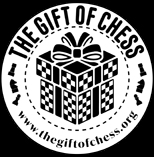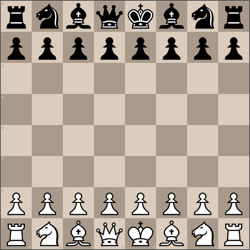March 15 1918
Salt Lake Tribune, Chess, Salt Lake City, Utah, Friday, March 15, 1918
(a) The usual move is P-B3 and the Handbuch gives as a reply 4. … BxN saying 4. … N-QB3, is followed by 5. Q-N3 Q-Q2; 6. BxPch QxB; 7. QxP, overlooking that this is only a draw after 7. … K-Q2; 8. QxR BxN; 9. PxB QxBP; 10. R-N1 QxKPch. Black may also reply to 4. P-B3 with either P-QB3 or N-Q2.
(b) P-B3 could not be played, so as to preserve the king's bishop.
(c) B-N3 or B-N5ch could be played, but there is nothing wrong with White's maneuver of playing so as to take with knight, only this knight should have been brought to K3 later.
(d) B-N5 followed by N-K3, was now in order.
(e) Unnecessary and creating a weakness on the king's side, which Black soon makes use of.
(f) Rather Q-K3.
(g) After this White cannot save the game. He probably overlooked Black's 23rd and thought he would get enough for his queen. K-R2 should have been played. Then 17. … BxR; 18. NxB R-B5 would have left the material even. Black having the advantage in position.
(h) Perhaps White on his 20th turn, in preferring Q-K2 to Q-K3, thought he could here play K-B3. But then 22. … Q-R6ch; 23. K-K4 Q-B4ch; 24. K-Q5 P-B3ch; 25. KxP P-K5, and mate could not long be averted.
(i) The simplest way to win.
Mor Weiss Testa (white) vs. Stasch Mlotkowski (black)
Philidor Defense
Submitted to chessgames.com on 05/03/2025
March 17 1918
Los Angeles Times, Chess, Los Angeles, California, Sunday, March 17, 1918
Chess.
Game No. 86—Ruy Lopez
Played in a simultaneous at the Pacific Chess Club on Washington's Birthday [February 22, 1918]. Mr. Testa, the only winner, played a good uphill game. Another will be given on March 28.
Stasch Mlotkowski (white) vs. Mor Weiss Testa (black)
Ruy Lopez: Cozio Defense
Submitted to chessgames.com on 05/06/2025
(a)—This move constitutes the Ruy Lopez. This is my first published game in which I adopted this opening, and I have never played it in a game of any importance, with one possible exception and that is in 1904 after the conclusion of the St. Louis tournament. Max Judd arranged that Jaffe and I should play three games for a small prize to the winner of each. He won the first and I the next two. In the second of those games I adopted the Ruy. I have never like it much, although it is the opening most in vogue at present and has been for a long time.
(b)—Steinitz thought P-B3 best. The Handbuch gives the text move as best.
(c)—N-B3 is usual here, but the move made is a good one and leads to a livelier game.
(d)—This, of course, is a mistake, losing a pawn, but, as often happens, White's positional advantage is diminished after he captures.
(e)—QxNP was theoretically safe, but would have given White such a hard game that under the circumstances it was thought best to pass the gain up, as too much time cannot be used on any one board in a simultaneous and Black, by replying Q-R4, could make it extremely uncomfortable.
(f)—N-B2 was more conservative.
(g)—Rather QxN.
(h)—I had calculated on R-K3 here and thought the move made merely desperate.
(i)—Failing to give the position proper consideration White loses. There is a win here by B-KB1, for if QxBch, K-R2 and Black has no safe check thereafter.
(j)—Testa's long check, which I had missed and upon which he no doubt relied when playing 30—… RxP. The game is now over, for if P-KK3, RxBch. When the queen gets to knight 6 Black has two exchanges ahead and White has a bad position.
April 28 1918
The Philadelphia Inquirer, Chess, Philadelphia, Pennsylvania, Sunday, April 28, 1918
We are pleased to note that Stasch Mlotkowski, formerly a member of the Franklin Chess Club, now residing at Los Angeles, Cal., recently gave a simultaneous exhibition at the Pacific Chess Club, meeting twelve of their members and winning all of the games.
June 16 1918
The Philadelphia Inquirer, Chess, Philadelphia, Pennsylvania, Sunday June 16, 1918
In the letter that we received last week from Stasch Mlotkowski dated Los Angeles, Cal., we note the following interesting comment on our article published several weeks ago, as to the importance of the imagination in making a first-class chess player. Mr. Mlotkowski comment is as follows:
“I cannot agree with you as to Rubinstein lacking imagination. When did either Capablanca or Lasker play such a game as he played against Rotlevi at Lodz in 1908, see Handbuch page 862. His combination in this game is not excelled by any of the performances of Anderssen, Morphy or Zukertort. Also see Handbuch page 320, Col. 29 and note 4 for his game with Salwe at Lodz in 1907. Also see L'Eco Degli Scacchi, August, September, 1917, for his game with Belsitzmann at Warsawin, March, 1917.”
Mr. Mlotkowski misunderstood our comment. If we recall correctly we stated that all first-class chess players must possess imagination of a fairly high degree, and Rubinstein unquestionably ranks among the first-class masters. We do believe, however, that Rubinstein, Tarrasch, Schlecter and several other of the leading chess masters of the present day have not the imagination possessed by Dr. Emanuel Lasker or Jose R. Capablanca and personally we are inclined to believe that Marshall, the American champion, has more imagination than either Rubinstein or Tarrasch. Imagination, however, cannot be mathematically measured and it is a personal equation and very few leading players would likely entirely agree on the relative degrees that different players now possess this quality.
(a) It is always a pleasure to see the Gambit accepted. For the past twenty years, however, the chess masters in important games have almost invariably declined the Gambit, the usual method being 4. B-N3. This move yields Black a thoroughly safe and satisfactory game.
(b) Even now after the Gambit has been accepted Black can obtain a good game by playing P-Q3, giving up the Gambit Pawn. This line of play was first brought into prominence by Dr. Lasker.
(c) White played this move with the object of getting his B-R3 and then to K6 closing the file.
(d) An interesting sacrifice, Black obtains three Pawns for the piece sacrificed. Mlotkowski states in his comments to us on the game that the sacrifice is unsound,, but not plainly so, as Black came within an ace of winning.
(e) This move Mlotkowski considers the winning combination. He returns the Queen for the Rook and Bishop, winning on the end game.
Stasch Mlotkowski (white) vs. Elmer Walker Gruer (black)
Italian Game: Evans Gambit, McDonnell Defense, Main Line
Submitted to chessgames.com on 05/05/2025
August 18 1918
The Philadelphia Inquirer, Chess, Philadelphia, Pennsylvania, Sunday, August 18, 1918
Problem No. 1331
By Stasch Mlotkowski
Black-Five Pieces
White-Ten Pieces
White to play and mate in two moves.
FEN 5N2/4R3/3p4/1Ppkp3/Rp4P1/1N2P3/B1K2P2/8 w - - 0 1
Solution: 1. Nd7 Kc4 2. Nd4#
September 01 1918
September 01, 1918. Mlotkowski also forwards to us interesting notes to the Evans-McDonald game by himself. These notes are well worth publishing, and we shall give them to our readers late.—Philadelphia Inquirer
September 08 1918
Philadelphia Inquirer, Chess, Philadelphia, Pennsylvania, Sunday, September 08, 1918
We take the following game from the British Chess Magazine. It was played in the National Correspondence Chess Association. The notes were especially contributed by Stasch Mlotkowski, formerly a member of the Franklin Chess Club, now at Los Angeles, California. The notes will be found of special value.
October 06 1918
The Philadelphia Inquirer, Chess, Philadelphia, Pennsylvania, Sunday, October 06, 1918
The two-move problem is an original composition by S. Mlotkowski and has never before been published. The problem is an interesting and neat study. Unfortunately, however, the key move is rather obvious.
The three-move problem was published some years ago, but is well worth a re-examination. The problem should be solved by our readers from the diagram.
Problem No. 1343
By S. Mlotkowski
White to play and mate in two moves.
FEN 2brrb2/p7/p7/7Q/1P1kPPp1/1Pp3N1/2K5/4R3 w - - 0 1
Solution: 1. Qf7 Bg7 2. Qxa7#
October 13 1918
The Philadelphia Inquirer, Chess, Philadelphia, Pennsylvania, Sunday, October 13, 1918
The following fine problem was composed especially for this column. Considering the comparatively few pieces the key move is well concealed and will we are sure for some little time baffle even our skilled solvers.
Problem No. 1345
By S. Mlotkowski
White to play and mate in two moves.
FEN 8/8/6R1/np1kbK1N/5P2/3PP3/8/2Q5 w - - 0 1
Solution: 1. d4 Nc4 2. Qh1#
The Los Angeles Times, Chess, Los Angeles, California, Sunday, October 13, 1918
Everett Robbins Perry (white) vs. Stasch Mlotkowski (black)
Queen's Pawn Game: Stonewall Attack
Submitted to chessgames.com on 05/03/2025
CHESS. Game No. 107—Queen's Pawn Opening. The first game of the play off in the tie for the championship of the Pacific Chess Club follow:
(a) This move was played by Tchigorin against Tarrasch at Hastings in 1895 and later was frequently adopted by Pillsbury in games against Showalter. In fact, fifteen to twenty years ago it was the recognized defense. Lately it has dropped out of fashion, the Handbuch giving P-QB4 as best, noting that B-N5 is also worthy of consideration.
(b) The usual move now is P-KB4.
(c) Rather B-K2. Then Black cannot play P-K4 unless he first takes off the White knight.
(d) Here Black should have played NxP; B-K2, N-N3, with the freer game.
(e) Q-N5ch was threatened, Black threatened N-N4.
(f) Black might have obtained the majority of pawns on the queen's side on his last turn by playing PxP, but there would have been no way of forcing the pawns down. White now prevents this. Soon, nothing is left. The draw was indicated after the exchange of queens.
CHESS PROBLEM NO. 42
By S. Mlotkowski
White—K on KB6, Rooks on QR5 and K6, B on Q2, Knight on QR7, Pawns on QB2, Q3 and KB3.
Black‐K on Q5, B on K5, Knights on KB7 and KN7, Pawns on QB2, KB4 and KN5.
Mate in 2.
December 08 1918
The Philadelphia Inquirer, Chess, Philadelphia, Pennsylvania, Sunday, December 08, 1918
We offer this week for consideration of our solvers an original two-move problem by Stasch Mlotkowski, formerly of this city, now residing at Los Angeles, Cal. Mr. Mlotkowski has only recently ventured in the realm of problem composers. As a player and able analyst, his name is known the world over. The three-move problem is a neat study with two Rooks and should be solved from the diagram.
Problem No. 1359
By S. Mlotkowski
White to play and mate in two moves.
FEN 8/Kb3prn/Q2N4/4pR2/3pP1nR/4kNp1/2Prp3/2qBB3 w - - 0 1
Solution: 1. Nh2 Bxa6 2. Rf3#























